
For an extensive source of information on Colombia, its military and its history, see: “Veritas Journal of Army Special Operations History PB 31-05-2 Vol. 2, No. 4, 2006”.
Columbia was the only Latin American country to send combat troops into Korea during the war. It was also the first time that Colombian forces had engaged in a foreign military operation in 127 years.
Colombia was a signatory to the Declaration of the United Nations in 1943, and one of the original 51 signatory countries at the San Francisco Conference held on Apr. 25-26, 1945.1 Colombian President Laureano Eleuterio Gómez Castro (1889 – 1965) was well aware of the United Nations concept of collective security and how it might potentially benefit Colombia in the future. With the outbreak of the Korean War, he pushed the military to form an expeditionary force that could be deployed on behalf of the United Nations, which in turn would bolster U.S. – Colombian relations. On Sept. 6, 1950, the Colombian government offered a naval unit to the allied forces, but two weeks later added an infantry battalion, which did not yet exist. Colombian Decree #3927 (Dec. 1950) created Infantry Battalion No. 1 which was to assist the United Nations efforts in Korea. Interestingly enough, formal diplomatic relations between the Colombia and South Korea were not established until March 10, 1962. Since then, Colombian Veterans have received significant help from the Korean government in the form of scholarships and financial aid for their grandchildren.
The Colombian Army
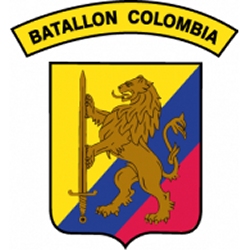
This design is found on Colombian shoulder patches used during the Korean War.
Excluding peacekeeping missions, Korea is Colombia’s only foreign military engagement. Colombia’s 1st Battalion was the first army unit to serve during the Korean Conflict. It arrived in Pusan, Korea on June 16, 1951, and was initially assigned to the US 24th Infantry Division, 21st Infantry Regiment. It subsequently was re-assigned to the US 7th Infantry Division, 31st Infantry Regiment. Colombia rotated 3 more battalions through Korea, all serving as part of the US 7th Infantry Division. Each of the 4 battalions had an approx. peak strength of 1,070 men. During the war, Colombian’s 3rd Battalion suffered the heaviest losses of the war. It was severely mauled during the fifth battle (March 23-26, 1953) on Old Baldy (Hill 268) when it was overrun by the numerically superior Chinese forces. In just ten days, the Batallón Colombia had suffered 313 casualties, the equivalent of two rifle companies. If not for the resistance of the Colombian troops at Old Baldy, the Chinese forces could have broken the 7th Division’s Main Line of Resistance and would have had a direct access route to Seoul.2 The Battalion suffered 95 killed-in-action, 30 missing-in-action and 97 wounded. The Chinese forces lost an estimated 750 troops. Old Baldy earned its nickname after artillery and mortar fire destroyed the vegetation on its crest. But as the highest point on a prominent east-west ridge, Old Baldy held strategic importance because it dominated terrain in three directions.
A total of 4,314 Colombian soldiers served in Korea. During the war, Colombia had a total of 163 killed, 448 wounded, 47 missing in action, and 28 prisoners of war. All the POWs were repatriated, with 6 during Operation Little Switch (April 20-26, 1953), and the remaining 22 during Operation Big Switch (August 5 to September 6, 1953). Colombian servicemen were awarded several foreign awards: 1 ROK Order of Military Merit, Ulchi Class, a ROK Presidential Unit Citation, 2 U.S. Legion of Merit medals; 18 U.S. Silver Stars; 25 U.S. Bronze Stars with V (valor) device and 9 U.S. Bronze Stars (without device) as well as 2 U.S. Presidential Unit Citations. One of the U.S. Presidential Unit Citations was for the Kumsong Offensive. The Batallón Colombia left Korea on Oct. 29, 1954, carrying home the remains of 141 soldiers. The veterans received a heroes’ welcome when they arrived at Buenaventura, Colombia on Nov. 25, 1954. Five days later, in Bogotá, the Batallón Colombia paraded proudly before thousands of people. In addition to the U.S. and Republic of Korea Presidential Unit Citations, all members received the UN Service Medal for Korea, the Republic of Korea’s War Service Medal. All the Colombian Army veterans were awarded the Colombian Valor Star for Korea. The Korean War was key to the development of a professional Colombian armed force. It also marked a new phase in the social and political transformation of the country. Having forged their leadership skills in combat, the officers of the Batallón Colombia led the country through some of its most trying times in the postwar period. Today, the legacy lives on as the Batallón Colombia serves as part of the Multinational Force and Observers in the Sinai.
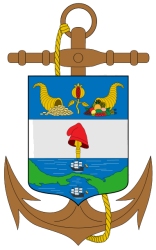
The Colombian Armada
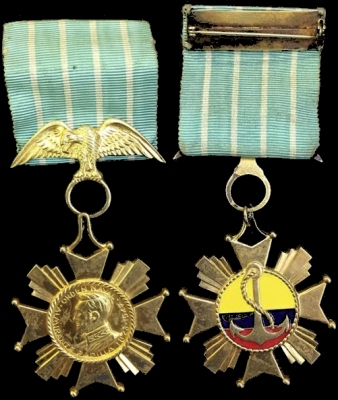
Orden del Mérito Naval ‘Almirante Padilla’
Protegemos el azul de la bandera “Protecting the blue of our flag”-Motto of the Colombian Navy
The Colombian Navy utilized three former US ships during the Korean War, with approx. 786 sailors servicing during the conflict. The ships utilized were: the ARC Almirante Padilla FG-11 (formerly the USCGC Groton PF-29) which served in Korea from May 8, 1951 to Jan. 19, 1952, the ARC CapitánTono (formerly USCGC Bisbee PF-46) which served from Nov. 23, 1950 to Oct. 20, 1951, and the ARC Almirante Brión F-14 (formerly USS Burlington PF-51) which served from July 18, 1953 to Oct. 11, 1955.3 For more information on the Colombian navy in Korea, see “Across the Pacific to War: The Colombian Navy in Korea, 1951–1955”. The original copy that I saw is no longer on the Internet. However, I did find a copy embedded in “Veritas Journal of Army Special Operations History PB 31-05-2 Vol. 2, No. 4, 2006”
I found on the Colombian Government website the following excerpt dated 02/11/2016. “’Medalla de Honor Excombatientes de la Guerra de Corea’, otorgada por la Asociación Naval de Veteranos Excombatientes de la Guerra de Corea al señor Coronel Jung Changwoo, Agregado Militar de Corea en Colombia”. Which translates as “Medal of Honor Ex-Combatants of the Korean War”, awarded by the Naval Association of Veterans Ex-Combatants of the Korean War to Colonel Jung Changwoo, Military Attaché of Korea in Colombia. I have been unable to find any other information or picture of the medal. The Association maintains a website at: https://asovexcor.wixsite.com/cartagena. They also maintain a webpage on the Colombian Navy during the Korea War.
The Colombian Order of Naval Merit Admiral Padilla (Orden del Mérito Naval “Almirante Padilla”) was established by Decree 2409 on July 8, 1947. The order is awarded to Colombian and foreign naval personnel in recognition of acts of valor, heroic actions, outstanding and distinguished professional service, and exemplary discipline and fellowship of personnel. It is awarded in six classes: Grand Cross (Gran Cruz), Grand Officer (Gran Oficial), Commander (Comendador), Officer (Oficial), Gentleman (Caballero), and Companion (Compañero). Admiral José Prudencio Padilla López (1784-1828) was a prominent Colombian naval commander during the wars of independence against Spain. I have no information if this order was issued for Korea, but it seems likely.

Korean Campaign Medal “Medalla de la Campaña de Corea”
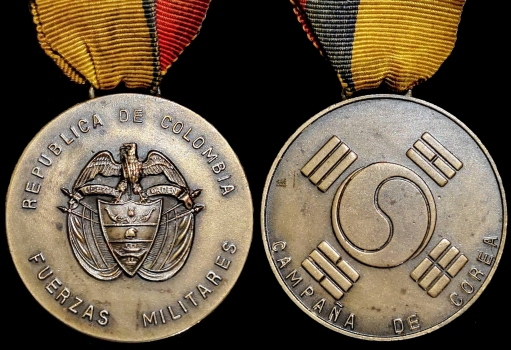
I have seen this medal referred to as “Medalla de la Campaña de Corea”, but I am unsure if that is the correct title. The obverse of this extremely rare bronze medal features the Seal of the Colombian Republic and the inscriptions, Republica de Colombia ‘Republic of Colombia’ and Fuerzas Militares ‘Military Forces’. The reverse features the Korean Taeguki (Korean Flag). In the rocker below is the inscription Campaña de Corea ‘Korea Campaign’.
Medal for Service in International War (Overseas Wars) “Medalla por Servicios en Guerra Internacional”
The medal for services in “International War” was created by Decree No. 812 in 1952. The awards are intended for members of the Military Forces, regardless of rank, who serve in foreign conflicts. The award has two categories, namely: an Iron Cross (Cruz de Hierro) and a Bronze Star (Estrella de Bronce). The planchet designs for each decoration were modelled on foreign decorations, namely: the German cross pattée design of the ‘Iron Cross’ and the U.S. ‘Bronze Star’. Both medals have identical ribbons with a Korean flag design centered on a white center stripe and narrow yellow-blue-red stripes on each side, which represent the Colombian National Flag. Both ribbons are fitted at the top with a passador suspension, a distinctive hollow buckle. Some later reproduction top bars have been observed with the inscription ‘Colombia’ or ‘Corea’. The Medal for Service in International War has only been authorized for issue during the Korean War (With a quick ribbon change, they could possibly be awarded for other conflicts, but to date have not.) For both types of award, a laurel device on the ribbon indicates distinguished valor, while additional awards are indicated by a bronze oak leaf.
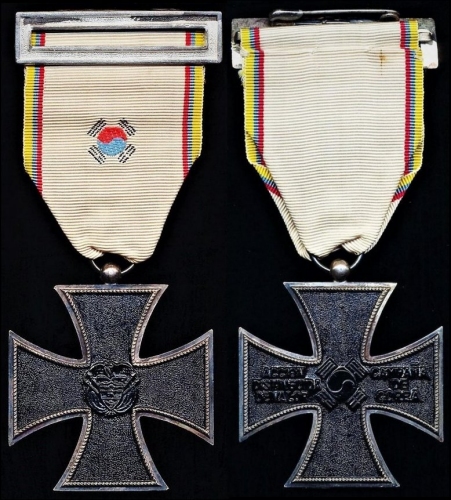
The Heroes Cross, ‘Cruz di Hierro’, commonly referred to as the Colombian Iron Cross
The Iron Cross was Colombia’s highest gallantry decoration for the Korean War. It could also be awarded for distinguished leadership in combat. It can be awarded with a laurel device (palm) for distinguished valor; or without for merit or devotion to duty in action.
The planchet obverse has the raised Colombian Coat of Arms. The reverse has a raised emblem of the South Korean flag, (a ‘Taeguk’ surrounded by 4 trigrams, same as the ribbon). On the left and right arms of the cross are the respective legends ‘Accion Distinguida De Valor’ & ‘Campaña de Corea’. The planchet is approx 44 mm, and mounted with a double ring suspension.
The Bronze Star, ‘Estrella de Bronce’
Medalla por servicios en “Guerra Internacional”, Estrella de Bronce (Medal for services in “International War”, Bronze Star). The Bronze Star was conferred by decree of the National Government to those members of the Colombian Armed Forces who served in international war.
The medal is a faceted five-pointed star in bronze. On the obverse, in the center, is the Coat of arms of Colombia surrounded by a wreath. On the reverse in the center is the national flag of the Republic of Korea, under the inscription ‘Campaña de Corea‘. The medals hang from a ribbon with an integrated lug suspension, not too dissimilar than a fob suspension slot.

The Medal of Honor for Mission Accomplished “HONOR AL DEBER COMPLIDO”
I have seen this medal listed as “Reconocimiento Honor al deber cumplido por el Batallón de Infantería de Colombia” (Recognition Honor for the duty fulfilled by the Colombian Infantry Battalion). However, I am not sure that this title is correct. This is an Infantry Battalion Medal which was established on Oct. 21, 1965 and issued to Colombian military personnel. The obverse has soldiers holding the Colombian flag atop a mountain, with a half-wreath of laurel leaves at the base of the medal. The flag is done in yellow, blue and red enamels. There is no hallmark. On the reverse, there is a shield with a rampant lion. This is the sleeve insignia of the battalion. In an arch across the top is the inscription “BATTALION DE INFANTERIA COLOMBIA”. At the bottom is the inscription, in two lines, “HONOR / AL DEBER COMPLIDO” (Honor / Mission Accomplished). The planchet is 31.5 mm (w) x 32.5 mm (h) and is suspended by a pinback hanger. These can be found in Bronze, Silvered Bronze, and according to some sources, pure silver. There was a dealer in Arizona, who purchased the original dies from Colombia, and produced these medals for many years. All the medals that I have seen with an original ribbon only have bronze pendants. However, Kevin Ingraham in his book, “Honors, Medals and Awards of the Korean War 1950-1953” states that the Colombian Infantry Battalion medal was struck on the order of LTC Ruiz-Novoa. A small number, probably no more than fifty, were struck in Japan in silver and that they may have been produced for the officers. He also states that the more common bronze issues may have been produced for the enlisted men. I found another information source that states that a rare variety of this medal was produced in Japan, which has several design variances, including the absence of the wreath at the base of the obverse. Personally, I believe that more research is needed.
This is commonly referred to as the “Old Baldy Medal”. Unfortunately, it is sometimes called the “Mount Baldy Medal”. The battle that the 3rd battalion fought in was at Old Baldy (Hill 266) in Korea and not at Mount Baldy, which is located in Southern California.

The picture source is: eMedals
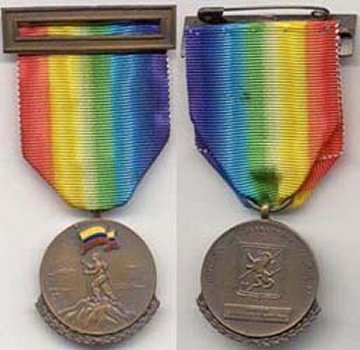
The picture source is: The Medal Hound

The picture is from the George Notarpole Collection.
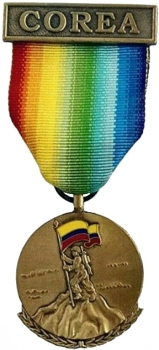

Medallas Colombianas SAS (MECO) is not the original manufacturer of Korean War era medals and decorations. They did not enter into the national economy until 1978. Meco arose from the sale of a company called FIBO LTDA, a company recognized in the market for more than 60 years for its excellent quality, service and experience. It was acquired by MECO SAS and became the fundamental basis for its recognition and positioning in the market.
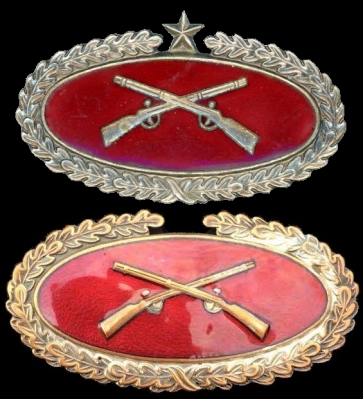
It is believed that the one with the star is for officers, and that without the star it’s for the enlisted ranks.
Combat Infantry Badge for International Conflict
This Combat Infantry Badge (CIB) is very similar in appearance to the wound badge. The center depicts two antique crossed muskets from the period of Colombia’s long struggle for independence from Spain. An independence that was finally achieved on July 20, 1819. The badge is surrounded by an elliptic oak-leaf wreath. Some badges have a reverse inscription “Battalon Infanteria” / “Corea”, in two lines. The Officer’s version has a star on the top, center of the wreath. These were also awarded to Americans who fought alongside the Colombians. American soldiers, who were awarded the badge, wear it on the right side of the chest as opposed to Colombian personnel, who wear it on the left.
Combat Wound Badge “Insignia de herida de Colombia”
The Colombian wound badges are approx 45 to 46 mm long x 15 to 16 mm wide. The badges have an outer gilt wreath/frame/border in the shape of an elongated oval. There are two types of background enamel, red and blue. A 3/16” bronze star is added for each of the first two wounds to the red enamel badge. Purportedly, a Combat Wound Badge with blue enamel is for the 3rd wound. However, Columbian Legal Decree #812, Article #14, with the date of “entry into force” being May 16, 1952, does not show a Wound Medal with blue enameling. At the bottom of this page, you will find Decree #812 translated into English. I suspect that this is a wound medal for the Navy. As stated above, their motto is Protegemos el azul de la bandera “Protecting the blue of our flag”.
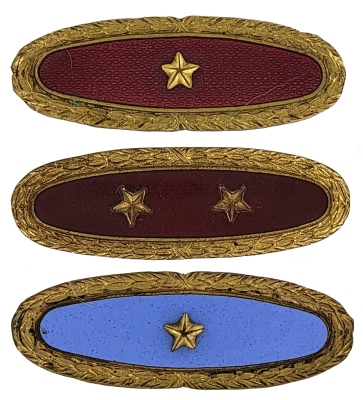
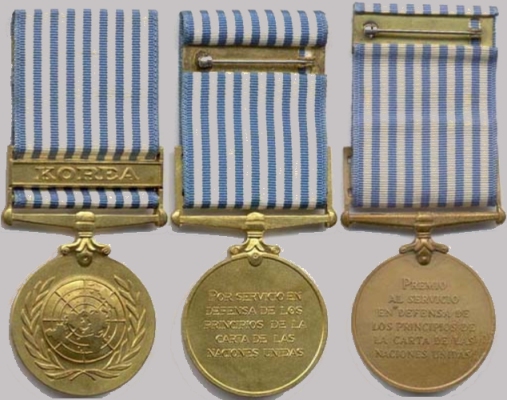
United Nations Medal for the Korean War
There are two Spanish types of United Nations Medal for the Korean War, and there are several websites which claim to have accurate information on the two types. In general, there is a “COREA” and a “KOREA” nameplate on the obverse, and sources vary on which one is authorized. There are two different inscriptions on the reverse. These are ‘POR SERICIO EN DEFENSA DE LOS PRINCIPIOS DE LA CARTA DE LAS NACIONES UNIDAS’, and ‘PREMIO AL SERVICIO EN DEFENSA DE LOS PRINCIPIOS DE LA CARTA DE LAS NACIONES UNIDAS’. And again sources vary on which one is authorized.
The Republic of Korea awarded the Order of Military Merit, Taeguk to the “Colombian National Hero” 코롬비아국무명용사 Killed in the Korean War 한국동란에서전몰한 on June 30, 1961. Unfortunately, I have not been able to get more information. It could be Lt. Col. Alberto Ruiz Novoa, who is credited with successfully leading a set of key wartime missions, including Operation Barbula against enemy outposts in Cheorwon, 71 kilometers northeast of Seoul, in March 1953. On June 24, 1953, shortly before his return home, the Korean government conferred the Ulchi Order of Military Merit on him for his wartime contributions. Novoa later served as the Colombian minister of war.
Korean War Veterans Organizations in Colombia
- Colombian Association of Korean War Veteran Officers (ASOVECOR) Asociación Colombiana de Oficiales Veteranos de la Guerra de Corea (ASOVECOR)
- Association of Descendants of Korean War Veterans (ADEVECO) Asociación de Descendientes de Veteranos de la Guerra de Corea (ADEVECO)
- Colombian Association of Korean War Veterans (ASCOVE) Asociación Colombiana de Veteranos de la Guerra de Corea (ASCOVE)
- Foundation of Colombian Veterans and Descendants of the Korean War (FUNVECOREA) Fundación de Veteranos y Descendientes Colombianos de la Guerra de Corea (FUNVECOREA)
- Naval Veterans Association of the Korean War Asociación Naval de Veteranos Excombatientes de la Guerra de Corea
Colombia has a war Museum located at Calle 10 # 4–92, Bogotá D.C., Colombia. Their website is located at www.museomilitarco.com/en/. Their email address is Museomilitar@cgfm.mil.co. They can also be contacted by phone.
Korea maintains a memorial to the Colombian Military who fought in the Korean War. It is located at 213-7 Yeonhi-dong, Seo-gu, Incheon, South Korea.
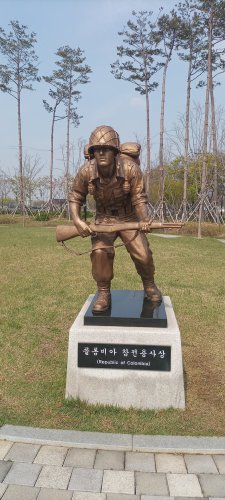
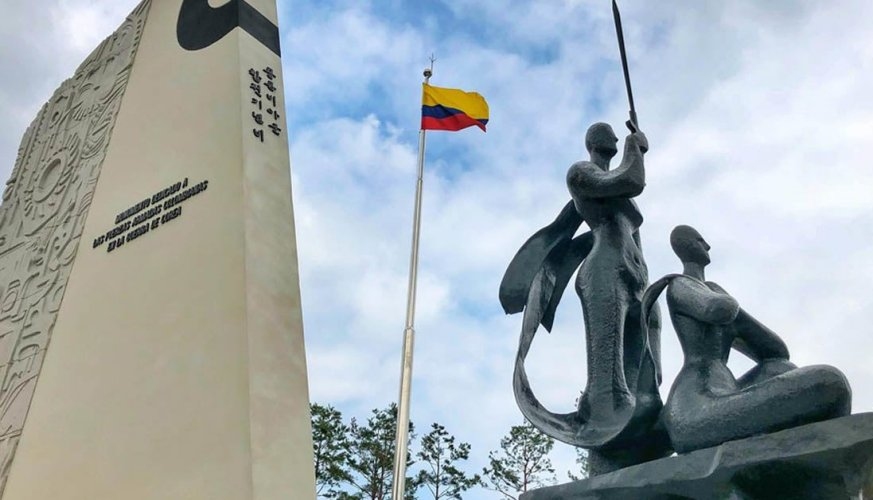
The following is the legal decree which covers the Colombian Iron Cross, Bronze Star and the Wound Medal
OFFICIAL DIARY. YEAR LXXXIX. N. 27903. APRIL 30, 1952. PAGE. 13.
DECREE 812 OF 1952 (March 27)
For which the Services in International War decoration is created
VALIDITY STATUS: Repealed.
Standard issue date 03/27/1952
Standard publication date 05/16/1952
Date of entry into force of the standard 05/16/1952
Subtype: ORDINARY DECREE
The designated person, in charge of the Presidency of the Republic of Colombia
Article 1. The “International War Services” decoration is created for members of the Military Forces who provide their contingent in wars of this nature.
Article 2. The “International War Services” decoration will have two categories, namely:
Bronze Star
Iron Cross
Article 3. The Bronze Star will be awarded to all members of the Military Forces who serve in international war.
Article 4. The Iron Cross will be awarded to those members of the Military Forces who, while providing their services in international war, stand out for a distinguished action of courage, an extraordinary act, outside the common performance of duty.
Article 5. The member of the Military Forces who is awarded the “Services in International War” decoration and dies before receiving it, will be awarded the decoration posthumously.
Article 6. The General Command of the Military Forces will prepare the draft resolutions through which the “Services in International War” decoration will be granted.
The Iron Cross will be awarded at the request of the respective Commander of the Army, Navy or Air Force, in International War, who will send to the General Command of the Military Forces for study and resolution the documents proving that the candidates have met the required requirements.
Article 7. The member of the Military Forces who, while serving in an international war, is wounded in combat, will be awarded the “Wounded in Combat” badge.
The “Wounded in Combat” badge will be awarded by the Order of the Day of the respective Command of the Army, Navy or Air Force, in International War.
Article 8. The decorations and badges awarded will be sent to the theater of operations so that the respective commander can impose them in a special ceremony.
Article 9. The diplomas that accredit the granting of the “Services in International War” decoration will bear the signatures of the minister of war, general commander of the military forces and the commander of the army, navy or air force, depending on the department to which it belongs. the graceful
Article 10. The diplomas referred to in the previous article will be endorsed by the head of the command personnel section of the army, navy or air force, as the case may be.
Paragraph. The personnel section of the army, navy or air force command will keep a record book of the decorations that are awarded.
Article 11. The diplomas that accredit the granting of the “Wounded in Combat” badge will bear the signature of the respective commander of the army, navy and air force in international war and will be countersigned by the respective assistant. In these commands, a record book will be kept of the badges that are being awarded.
Article 12. The diplomas corresponding to the “Bronze Star” will contain the following legend: Republic of Colombia — Military Forces — Decoration “Service in International War.” Bronze Star awarded to…….by resolution number…. In view of having provided his services in the campaign of …… in the year of ……
Paragraph 1. The diplomas corresponding to the “Iron Cross” will contain the following legend: Republic of Colombia — Military Forces Decoration “Service in International War.” Iron Cross, for distinguished action of valor in the campaign of….in the year…..awarded to……by resolution number….
Paragraph 2. The diplomas corresponding to the “Wounded in Combat” badge will contain the following legend: “Republic of Colombia” military forces. Badge “Wounded in Combat” awarded to …….in the campaign of……..in the year of……
Article 13. The “Services in International War” decoration will have the following characteristics:
Bronze Star
It will have five points, with a separation of twenty-five (25) millimeters between them and a diameter of forty (40) millimeters. On the front it will be engraved, in the center. The coat of arms of Colombia bordered with laurel. The backrest, and at the top, will have the inscription Campaign of…… engraved.
Iron Cross
Made of malt and forty-five (45) millimeter axles. On the obverse, in the center, the coat of arms of Colombia will be engraved. On the back at the top, it will have the inscription “Distinguished Action of Valor” engraved and at the bottom the inscription: “Campaign of……
Paragraph. The general command of the military forces will determine in each case, depending on the campaign in question, the characteristics of the ribbon from which the “Bronze Star” and the “Iron Cross” badge must hang. Likewise, the other details that must be recorded on the decorations.
Article 14. The “Wounded in Combat” badge will consist of a purple plaque, bordered with laurel, elliptically shaped fifty (50) by ten (10) millimeters, in the center of which will be the stars according to the number. of wounds received in combat.
Communicate and publish.
Given in Bogotá, March 27, 1952.
For further reading, see:
Briscoe, Charles H. “Across the Pacific to War: The Colombian Navy in Korea, 1951-1955.” Veritas Vol. 2, No. 4: pp. 24-29. Per.
_____. “Barbula and Old Baldy, March 1953: Colombia’s Heaviest Combat in Korea.” Veritas Vol. 2, No. 4: pp. 15-23. Per.
Coleman, Bradley L. “The Colombian-American Alliance: Colombia’s Contribution to U.S.-Led Multilateral Military Efforts.” PhD dss, U GA, 2001.275 p.UA625C64.
_____. “The Colombian Army in Korea, 1950-1954.” Journal of Military History (Oct 2005): pp. 1137-77. Per.
Davison, Daniel. “The Colombian Army in Korea: A Study of the Integration of the Colombia Battalion into the 31st United States Infantry Regiment Based on the Experience of Major General Lloyd R. Moses.” Thesis, U SD, 1972. 112 p. DS919.7C7D38.
Fox, William J. “Inter-Allied Co-operations During Combat Operations.” Draft, Mil Hist Sect, Far East Command, Tokyo, 1952. pp. 151-53. DS918H57v3pt11.
Korea (Republic). Ministry of Natl Def. The History of the United Nations Forces in the Korean War. Vol. 3. Seoul: Ministry of Natl Def, 1972. pp. 125-72. DS918K55v3.
Ruiz Novoa, Alberto. El Batallon Colombia en Korea, 1951-1954. n.p., n.d. 66 p.+ DS919.7C7R8
U.S. Army. 7th Inf Div. Bayonet: A History of the 7th Infantry Division. Tokyo: Toppan, 1952. 75 p.#05-7.1952. See pp. 27-29; also other KW unit hist of 7th ID for scattered photos.
U.S. Dept of the Army. General Staff, G-2. “Ability of Latin American Armies to Furnish Effective Combat Teams.” Intell Rev (No. 184, Sep 1951): pp. 57-61. UB250R484no184.
_____. “Latin American Soldiers in Modern Warfare—The Colombian Battalion in Korea.” Intell Rev (No. 207, Aug 1953): pp. 45-50. UB250R484no207.
Footnotes:
- The Conference agreed upon the Charter of the United Nations and the Statute of the new International Court of Justice. The Charter had to be approved by the respective governments of the delegates. The Charter would not come into force until the governments of China, France, Great Britain, the Soviet Union and the United States and a majority of the other signatory states had ratified it through their respective governments. On Oct. 24, 1945 (now observed annually as United Nations Day) this condition was fulfilled, and the United Nations came into existence.
- The Battle of Old Baldy actually refers to a series of engagements, which were spaced over a ten-month period.
- “ARC” stands for “Armada de la República de Colombia”.
